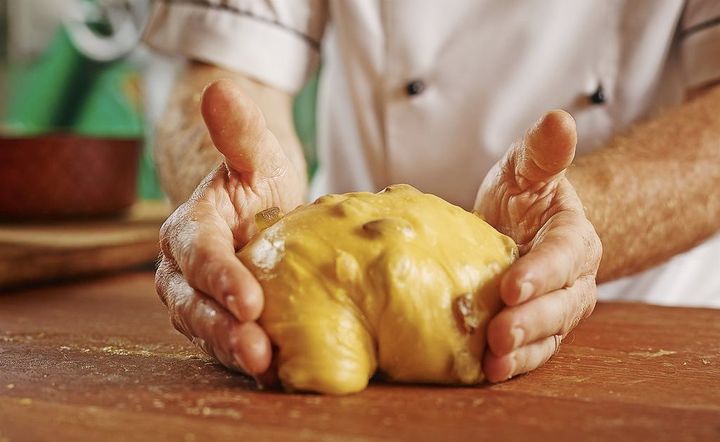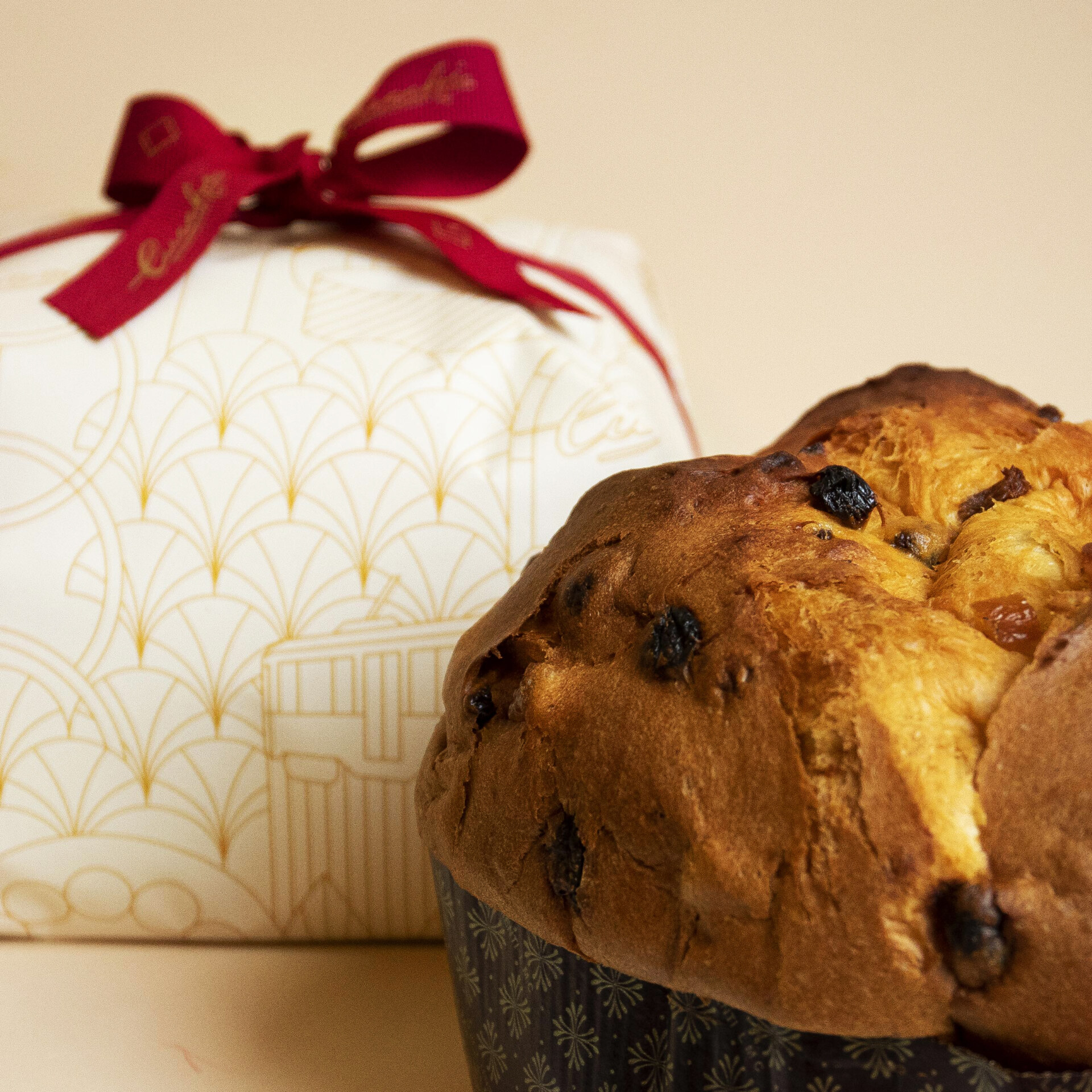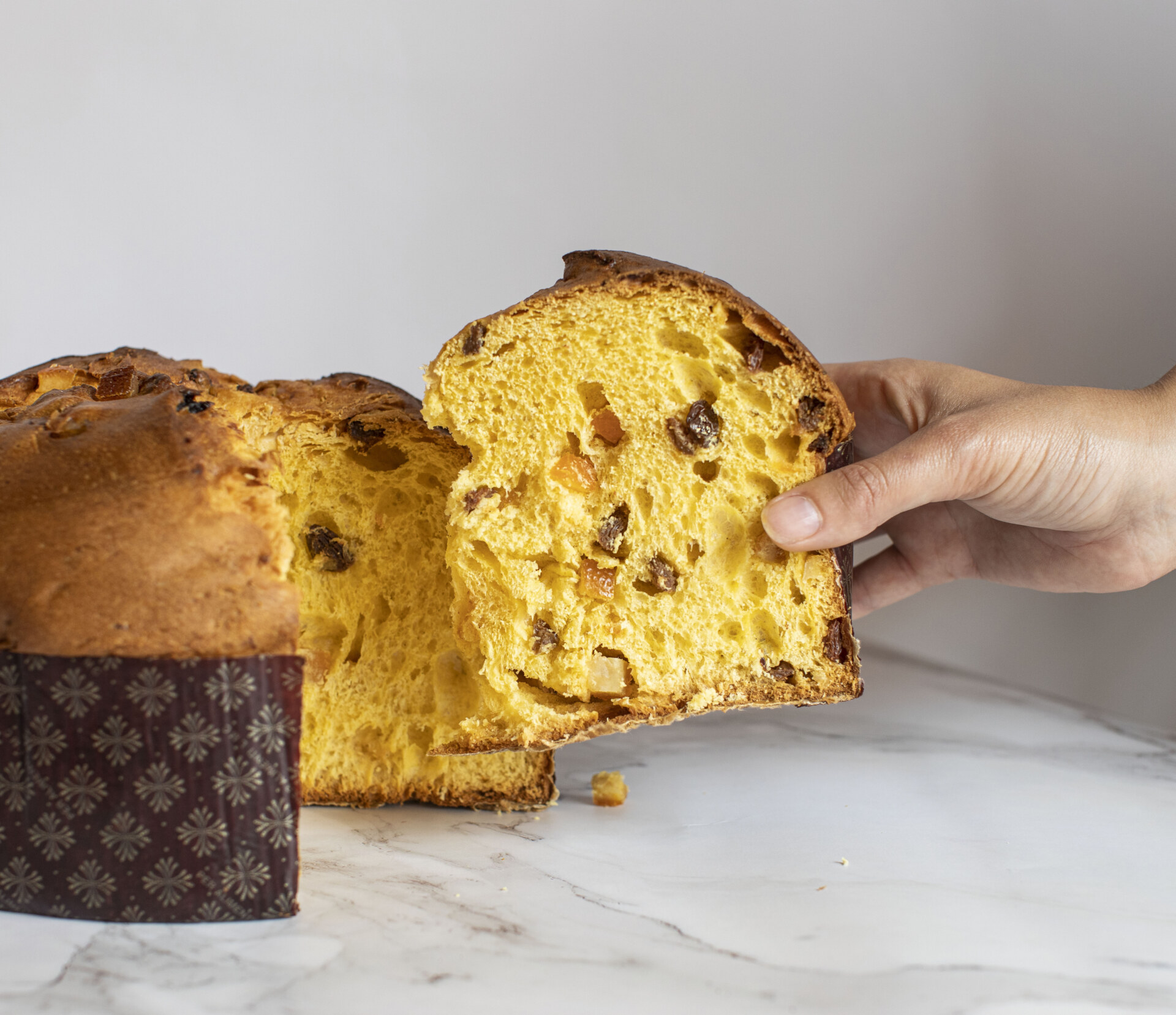If you happen to walk by Milan’s Pasticceria Cucchi around this time of year, the panettoni in the window displays will likely make you stop and do a double take. Beautifully wrapped or standing “naked” among the Christmas decorations, the sweet breads will beckon to you with their deceptive simplicity, enticing you to go in, perhaps to purchase your very own to take home or perhaps to order a slice (3.50 euros/piece) to pair with your espresso.
Passing on the chance to do either (or both) would be a terrible mistake. Pasticceria Cucchi, a historic pastry shop that’s been around since 1936, is the king of artisanal panettone. To say they make it well would be an understatement.
A Milanese institution—just ask any local—Cucchi started as a caffè concerto or cafè chantant in the 1930s, before turning to the art of fine patisserie and, of course, panettone (not exactly a dainty sweet, but an elaborate baked good nonetheless) after WWII. Ever since then, the family-run pasticceria has become the go-to for the beloved fruitcake, which they have always made on site, expanding into a slightly larger facility only recently to meet growing demand. And growing it has: these days, in the run-up to Christmas, Cucchi produces around 4,000 to 5,000 kilos of the stuff monthly.
While many commercial panettoni draw from other regions and feature a hazelnut glaze decorated with almonds (Piedmont) or a hefty height (Liguria), Cucchi’s panettone is the classico Milanese—purists’ favourite—laced with high-quality vanilla, plump raisins and candied citrus (orange, lemon peel, Sicilian citron), then baked into a low, round loaf. It is gently sweet and airy, with a pleasing brioche-like quality. They also offer a version with chocolate chips and one with marron glacé—both recent additions. All of them, unsurprisingly, are a far-cry from the mass-market panettoni filling Italian supermarkets.
For Laura Cucchi, the third-generation owner (together with her sister Vittoria), panettone is not just a treat to enjoy, though that’s certainly a big part of its appeal, but the epitome of Milan’s culinary heritage—a specialty that originated here in the 1400s.
“Our panettone is made the way Milanese tradition asks for,” she tells me as we sit down at one of Cucchi’s tables on a rainy morning in late November. “From the ingredients to the recipe and method, the baking time and the feeding of the lievito madre (live yeast), we stick to the original rules, because we want to preserve the craft—and give customers a really, really great panettone.”
The craft, as Laura describes it, is a pretty complex affair. From the dough’s fermentation to the microclimate of the bakery, every little thing in Cucchi’s panettone contributes to transforming a handful of pantry staples—butter, eggs, flour, sugar—into something unique.
“Panettone needs the right time, the appropriate humidity, the correct balance of all its components and adequate rest,” Laura says. “Even the simplest gesture must be well calibrated.” Only then, she adds, can you achieve the right product.
“Panettone is magic,” she says matter-of-factly.
It undeniably is.

Italian Christmas isn’t Christmas without a panettone (or two) on the table. The dessert is the perfect end to our lavish meals—the cenone and the pranzo di Natale—even when we’re too stuffed to eat anything else (or so we claim). It’s the binding agent of too many tombola games to count, and the only way to do breakfast right from December 25th to the end of the holiday season on January 6th (though in Milan, panettone leftover from Christmas resurfaces on the morning of February 3rd, San Biagio, as it’s said to keep away ailments and protect from sore throats).
“I like to think of panettone as our very own Proustian madeleine,” Laura says. “For an Italian, opening a panettone and taking in its scent is almost like a sensory experience. Other cakes might be more visually elaborate and sophisticated, but panettone has the ability to jolt our memory in a way few foods can. It speaks of holidays, of family time. We identify with it for being both simple yet immensely complicated.”
Not that Pasticceria Cucchi reserves its panettone only for Christmas.
While the leavened bread is generally associated with the festive season and most pastry shops only sell around then, the Cucchi family bakes it all-year round (in smaller quantities: around 80 kilos monthly).
That’s because, as Laura tells me, panettone wasn’t born as a “dessert natalizio,” but rather as a delicacy made for religious celebrations. Back in the 1400s, Italians used to bake special, sweetened loaves to sanctify holidays, offered in church or among relatives. Panettone was one of those loaves.
“It’s not a seasonal cake, and we don’t treat it as one,” she says. “You could come here in July and be able to try it. We want to honour panettone as one of Milan’s most significant recipes, not just something to indulge in for one month of the year.”
Still, the winter holidays are prime time for the pasticceria, with customers beginning to place their panettoni orders as early as October (though Laura assures me that until the week before Christmas there’s no real need to reserve the pillowy bread, as they make plenty).
Some of the patrons have been buying from the pastry shop for decades—“the most rewarding of things,” Laura says, “especially when they come with their children or grandchildren, who then become clients themselves.” Others, often of younger ages, come drawn by the collaborations Cucchi has done in recent years, which have enlisted design and fashion names like Cristina Celestino, JJ Martin and, for Christmas 2022, MSGM to help with cool window displays, furniture collections and even hoodies.
“The pasticceria is almost the same as it was 1936, but everything around us has changed, and so we too are looking for new ways to evolve,” Laura says. “Our recipes might be rooted in the past, but we have our eyes firmly set on the future.”
Which is all to say that Cucchi’s panettone isn’t going anywhere. If anything, it will keep feeding generations of Italians to come, sparking fond memories of Christmases past one bite at the time.




